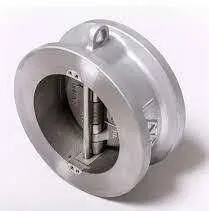
- Call Us
- +8618633052223
- njhdvlz@163.com
Sep . 24, 2024 06:20 Back to list
Factors Influencing Performance of Compression Check Valve Manufacturing Facilities
Understanding Compression Check Valve Factories An In-Depth Overview
In the realm of industrial applications, compression check valves play a crucial role in ensuring fluid control systems operate efficiently. These valves are designed to allow fluid to flow in one direction while preventing backflow, making them essential components in various industries, including water treatment, oil and gas, and manufacturing. This article provides an overview of compression check valve factories, emphasizing their significance, production processes, and the factors influencing their performance.
The Significance of Compression Check Valves
Compression check valves are often employed in systems where the prevention of backflow is vital for safety and operational efficiency. They are commonly used in pipelines, pumps, and other fluid-handling equipment. By ensuring that fluids flow in the desired direction, compression check valves protect equipment from potential damage caused by reverse flow, which could lead to leaks, contamination, or system failures.
The importance of these valves cannot be understated, as they contribute not only to functional reliability but also to the longevity of the broader system. In industries such as wastewater management, for instance, the use of check valves can prevent backflow that may lead to environmental hazards or health risks.
Production Processes in Compression Check Valve Factories
The manufacturing process of compression check valves involves several key steps, each crucial to ensuring the final product meets industry standards and customer specifications.
1. Material Selection The first step in the production process is selecting the appropriate materials. Compression check valves are typically made from metals such as brass, stainless steel, or plastic, depending on factors such as desired durability, corrosion resistance, and fluid compatibility.
2. Machining and Forming After material selection, the manufacturing process includes machining and forming the valve components. This may involve turning, milling, and stamping processes to achieve the precise dimensions required for optimal performance.
3. Assembly Once the individual components are manufactured, they are assembled into complete check valves. This step often requires skilled labor and may include the addition of gaskets or seals to ensure leak-proof functionality.
compression check valve factories

4. Testing and Quality Control Before the check valves leave the factory, they undergo rigorous testing procedures to ensure they meet all performance and safety standards. This includes pressure tests, flow tests, and sometimes even durability tests to assess long-term performance under different conditions.
5. Packaging and Distribution Finally, the completed valves are packaged for distribution. Proper packaging is crucial to prevent damage during transport and ensure that customers receive their products in perfect condition.
Factors Influencing Performance
Several factors can influence the performance of compression check valves, including
- Design Specifications The design and configuration of the valve can significantly impact its effectiveness. Factors such as size, flow rate capacity, and material used play crucial roles in determining how well the valve performs under different conditions.
- Maintenance Practices Proper maintenance is essential for ensuring the longevity and reliability of compression check valves. Regular inspections and timely replacements of worn components can prevent operational failures.
- Environmental Conditions The environment in which these valves operate can affect their performance. Extreme temperatures, corrosive substances, and varying pressures are all factors that need to be considered to ensure that the chosen valve is suitable for its application.
Conclusion
Compression check valve factories are fundamental in producing vital components that support efficient fluid management across various industries. As technology continues to advance, these factories are likely to evolve, integrating new manufacturing techniques and materials to enhance the functionality and durability of compression check valves. Understanding the intricacies of their production helps stakeholders make informed decisions regarding the selection and maintenance of these critical components.
-
Double Flanged Short Pattern Butterfly Valve | Compact, Efficient Flow
NewsAug.01,2025
-
Precise 3-Inch Butterfly Valve Dimensions | Durable Flow
NewsJul.31,2025
-
3 Butterfly Valve Dimensions | GPT-4 Turbo Precision Specs
NewsJul.31,2025
-
Stainless Steel Sanitary Butterfly Valve for Hygienic Flow Control
NewsJul.30,2025
-
High-Performance Groove Butterfly Valve for Easy Installation
NewsJul.30,2025
-
High-Quality 2 Inch Butterfly Valve for Precise Flow Control
NewsJul.29,2025